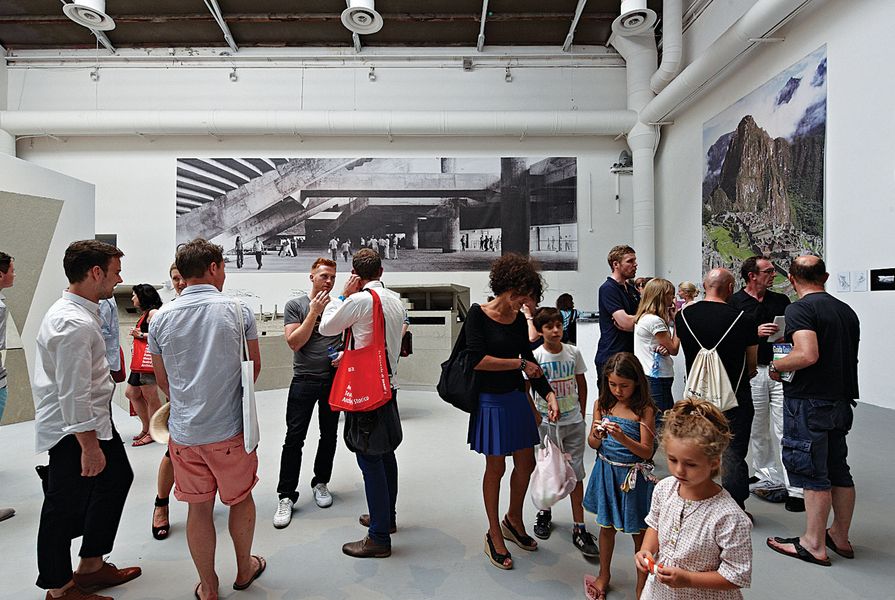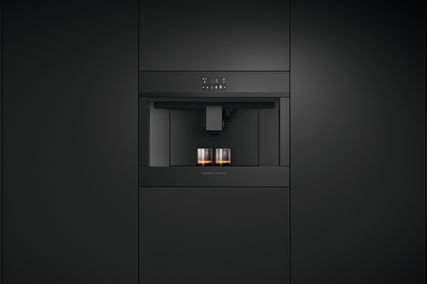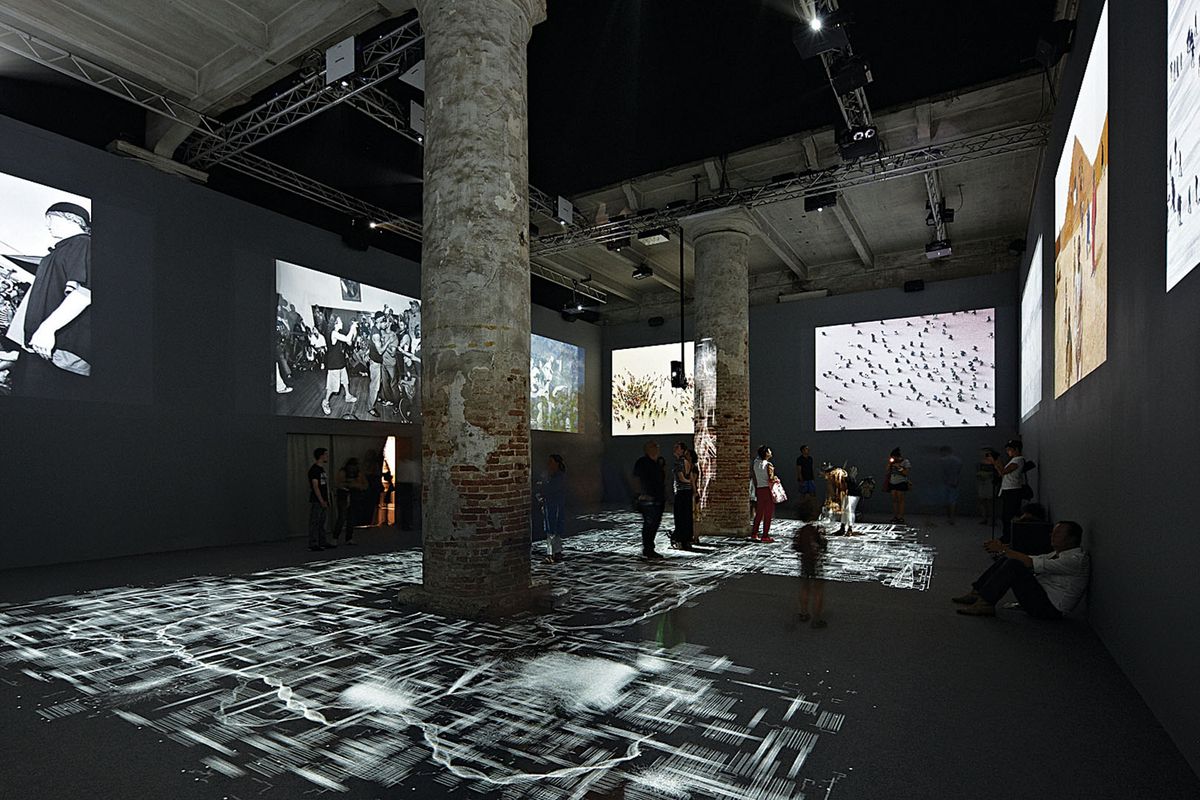Bending down to peer through a small peephole in the wall, I can glimpse a woman in a negligee rise from her bed, stretch and stroll out of view, leaving her partner sleeping in the stylish mid-1960s bedroom. Next to me, a man stands on tiptoe, craning his neck to watch through his chosen hole a similarly teasing and incomplete sequence of ordinary activities in what seems to be the same (less than) ordinary modernist Brazilian house.
We move from keyhole to keyhole along this thick black wall of capriciously placed apertures. There are some twenty of us, an orchestrated choreography of voyeurs shuffling and crouching our way around the room, trying to piece together the story from the snippets of film we can spy through the peepholes. Some excerpts are mundane, for example a maid washing the floor. Some are ambiguous – a slightly too handsome electrician at a meter box. All are accompanied by a soundtrack of idle whistling. And all are charged with a sense of something about to happen.
Peep by StudioMK27 provided a view into life in the V4 house. Image:
Peter Bennetts
Piecing together the fragments into a cohesive narrative was the challenge thrown down: the innocuous interior and domestic settings suggested much pithier observations of political and social structures. Piecing together the many parts of director David Chipperfield’s Biennale, and its Common Ground theme, was a less explicit invitation and the conceptual thread more elusive, but there are parallels.
Any Biennale is episodic; every Biennale is seductive. The physical presence of the Arsenale buildings – visceral, industrial, thick with humid light and age – imbues everything inside with weight, either empathically reinforcing the grain and texture of built pieces, or providing the patinated backdrop for slick, reflective digital representations. The Giardini, in comparison, is Arcadian – a picnic among expressive follies, where elegant flâneurs of design strolled and chatted and sipped Aperol spritzers, spreading the buzz about which country’s pavilion is the hottest.
The Russian pavilion at the 2012 Venice Architecture Biennale.
Image: Peter Bennetts
This year it was Russia and its i-city installation: a dazzling conversion of the pavilion into a domed cathedral of QR codes and chapels covered with constellations of glazed lenses.
Each element connected to detailed data on current and past projects in Russian urban geography – including the secret gated cities, and chilling military infrastructure of the Cold War accessed via spy-holes – while the punched steel traceries of QR codes triggered links in the tablets visitors were given on entry. Every few moments the entire wall surface would reset, shifting the selection and location of hot spots, and blurring the room boundaries with disco-worthy lighting effects.
Despite its technically brilliant visualization, this was a paradoxical project. The formal geometries and intricacies of the surface patterning evoked the order of Islamic spaces, yet the dynamic and random accessing of data defied conventional archival transparency and linearity.
In a contrast so stark as to almost seem like parody, the USA presented Spontaneous Interventions: Design Actions for the Common Good.
This was three essentially identical rooms of rainbow-hued pull-down blinds, the reverse side printed with outlines of specific urban regeneration projects and “citizen-led alternatives,” each counterweighted to panels on the wall and giving handy aphorisms for architectural agency. Worthy it may well have been, but the abiding impression was of a plastic-scented Luxaflex showroom.
Gateway, by Foster and Partners with Ivorypress.
Image: Peter Bennetts
There was a powerfully elemental characteristic to the best of this year’s Biennale, an almost naked engagement with the body and its architectural setting. At the comprehensive end of this type of exploration, Anupama Kundoo’s 1:1 recreation of her South Indian Wall House was remarkable; the work should make her new hosts at the University of Queensland proud to have her on board. The seamless blend of the experiential and didactic was experienced when walking through the layered thresholds, volumes and intense craft of this model that is not a model.
More singular in approach, the Polish pavilion stripped the space bare of distraction; it was just an expanse of unfinished timber floor and subtly warped rendered walls that whispered, echoed and clanged when you placed your ear against them. Further on, there was the more violent acoustic of the Serbian pavilion with its vast hollow table, designed to be beaten and thumped, like bad guests at some out-of-control meta-dinner party. Soundscapes were everywhere, in everything from StudioMK27’s just-audible whistling peepholes, to the stirring and cinematic panoramic installation by Norman Foster, Gateway. (And, of course, the entirely sound-reliant architecture of Australia’s own The Architects radio show, and their quaint mobile broadcasting trolley).
Perhaps this all suggests a certain ennui about the visual, or more probably it is part of the desire to set up evocative immersive experience in this compressed, competitive field – to make veritable soundbites of architecture.
Like Peep, the Biennale fed on the attraction between art and architecture. More tactile than art museums – you could touch, sit on, walk through and over many of the “art” pieces at the Biennale – there was nevertheless a sense of being within an artwork, rather than an architectural, or even sculptural, work.
Most of the pavilions had highly charged curatorial intent and control. Some were intensely sensual while several strayed into the area of performance art, such as the exquisite collection Spain Mon Amour, where commedia dell’arte characters dressed in white zoot suits and archivist’s gloves presented models to discuss with interested spectators. The theatrical choreography of their movements and delicate handling of the models heightened the sense of architecture as precious artefact, an observation that could be made of many works in this Biennale, especially those in Chipperfield’s invited section of the Arsenale.
The prevalence of models — particularly sectional ones — was noticeable, as was the presence of large-format, state-of-the-art photography. In both cases the emphasis was arguably more on the technology and abstraction of the representation rather than on communicating content. Undeniably impressive as rooms and rooms of golden models (literally) and glowing C-type photographs were, they left a lurking anxiety that this was a Biennale of good taste and respect for the canons of architecture.
There were a few exceptions. OMA’s grungy display of municipal architecture highlighted the stern, robust and mostly anonymous buildings that form the backdrop of our cities. Less successful was the polemically political and frankly ugly British pavilion, with its borrowed ideology and aesthetic of 1960s and 1970s activism. Perhaps they were all too busy with the Olympics, but they weren’t the only group to seek credibility in revisionism of that era, or of mundane architecture generally. The references to and imagery of typologies and things we’ve seen before – housing blocks, solid civic works and pragmatic infrastructure projects – were rife, albeit “sexed up” with stunning representations. What does this say about our current architectural self-confidence and belief?
Large-format photography was popular throughout the pavilions.
Image: Peter Bennetts
The 2008 Venice Architecture Biennale director Aaron Betsky pulled few punches in his scathing interpretation of what he believes it says. Speaking at the Australian flash mob Formations forum, to a crowd gathered like acolytes at his feet on the rug thrown on the steps of Accademia Bridge, his words cut through the bonhomie of three days of architectural entertainment and stimulation.
Worse than boring, he found this year’s offering offensive, specifically the safe content of the Arsenale. For him the Biennale is the prime way of pushing architecture’s potential as a way of seeing, a way of thinking; he doesn’t believe it should be an elegant, respectful exercise in detailing or making or buttressing existing conventions of practice.
The country pavilions in the Giardini, with their speculative and interrogatory content (reversing the norm, where the Arsenale has usually been most avant-garde) fared a little better in his assessment. But if this is architecture’s immediate future, Betsky declared, “I’m with Amy Winehouse – I say no, no, no!”
Three days before, I had visited Chipperfield’s Courtyard of the Four Evangelists on the Isola di San Michele. The only contemporary addition to this wonderfully melancholic Napoleonic walled cemetery, in terms of architectural opportunity it should surely be the Venetian equivalent of shooting fish in a barrel. Yet the building is oddly mute: it is based on a contrived plan where the geometric logic is evident but never resonant, and at the time of my visit was full of functional gaffes that had brooms, ladders and rubbish bins taking up the most loaded or contemplative spaces.
While there was clear intent to frame inwardly and outwardly, to collect the fragments of human life and impart them with significance through architectural gesture, the whole thing felt, well, dead. It is probably a much harder task to curate a Venice Architecture Biennale, to summarize the exuberant, difficult and contradictory complexities of global architectural activity, even over ten thousand square metres of available exhibition space. But perhaps one shouldn’t try to keep it tidy or nice.
Perhaps Peep, with its subversive mix of the known, the guessed at and the desired, is a more compelling insight into architecture.
From the Architecture Australia (Nov/Dec 2012) dossier on “competitions, exhibitions and events of 2012.” Further coverage of the 2012 Venice Architecture Biennale.
Source

Discussion
Published online: 19 Dec 2012
Words:
Rachel Hurst
Images:
Peter Bennetts
Issue
Architecture Australia, November 2012























